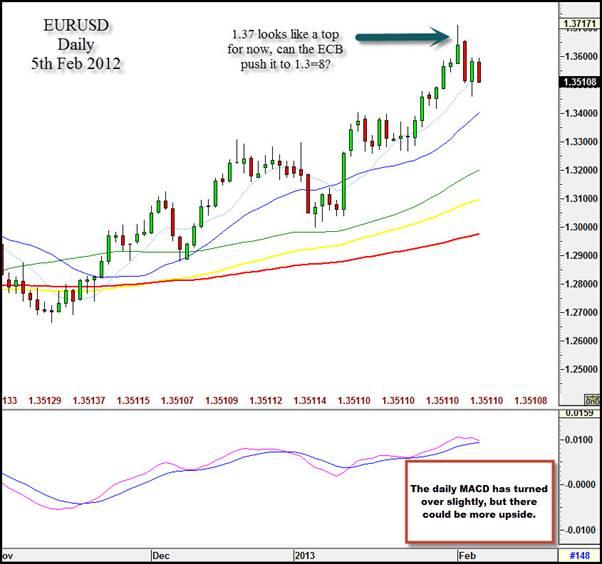What the market expects:
The market doesn’t expect any change to policy at this month’s meeting, but it is President Draghi’s press conference that really matters. The market wants to know a few things: 1, Draghi and co’s view on the rising euro; 2, what it thinks about banks paying back LTRO loans early, which is shrinking the ECB’s balance sheet; and 3, whether or not the ECB is concerned by the recent rise in bond yields in Spain and Italy.
The RBA in Australia, the RBNZ in New Zealand, the Bank of England and the Bank of Japan are some of the central banks who have mentioned their currency’s strength and its hindrance to growth in recent months. This has fuelled fears of global currency wars. The ECB traditionally does not comment on the euro; however will it want to be the last to the currency war party? If the ECB wants the Eurozone economy to re-balance then a weaker currency could help this. However, we don’t think that the ECB will mention the euro directly at this meeting; instead it may skirt the issue by saying that currencies should reflect fundamentals.
We believe that Draghi will be asked about banks paying back LTRO loans in recent weeks. Banks have paid back more than 10% of LTRO loans in the past few weeks, yet some of these banks have reported rising bad loan rates. Added to this, the latest bank lending survey showed a tightening in lending to businesses and households in some part of the Eurozone at the end of last year. Thus, the argument that banks paying back their LTRO loans is a sign of further stabilisation in the currency bloc looks fairly flimsy as it suggests that the “transmission mechanism”, which helps ECB policy impact the real economy in the Eurozone, is still under pressure and may require further policy action from the Bank in the future.
In recent meetings, the ECB has been able to justify holding steady because of the stabilisation in the peripheral bond markets, most notably in Spanish and Italian bond yields. In recent sessions, bond yields in Spain and Italy have risen to their highest levels in more than a month. Draghi is unlikely to want to spook the markets, and we expect him to say that conditions in the currency bloc continue to stabilise, but that strong vigilance is required.
He may also mention the latest review of the financial assistance programme for Spain that was released late last week. The review said “important progress” has been made on separating bad assets from good assets on banks’ balance sheets and also in implementing reforms and governance programmes particularly for the weak domestic savings banks. However, it also warned about potential pitfalls including rising unemployment, and added that further reforms need to be made.
We believe that Draghi will strike a similar tone, and he may say that the ECB’s policy so far continues to help stabilise sovereign issues in the region but that governments have plenty of work still to do to make their economies more competitive and bring down debt levels. We believe there is only an outside chance that Draghi will mention the strength of the euro as a hindrance to growth. However, if he does this may cause a sharp move lower in the euro.
Market Forecast
EURUSD managed to find support at 1.3450 after selling off earlier this week. This appears to be a temporary low. Above 1.3700 attracted significant selling interest on Friday and is a major resistance level. If the ECB remains on hold and does not sound particularly worried about the strength of the euro or the recent rise in Spanish bond yields then we could see the euro strengthen across the board as the relative hawkish stance of the ECB compared to other major central banks boosts the single currency. This may see EURUSD rise above 1.3720 towards 1.38 in the near term, and it could also have a large impact on EURJPY, causing it to break above the key 127.00 resistance zone. In contrast, if the ECB sounds concerned about the strength of the euro and political risks in Spain and Italy then we may see a selloff in the single currency.On balance, the ECB may strike a more hawkish tone than other major central banks at this month’s meeting, which may be euro positive in the short term, as long as sovereign concerns don’t flare up once more.
Chart: EURUSD daily

Recommended Content
Editors’ Picks
EUR/USD holds below 1.0750 ahead of key US data

EUR/USD trades in a tight range below 1.0750 in the European session on Friday. The US Dollar struggles to gather strength ahead of key PCE Price Index data, the Fed's preferred gauge of inflation, and helps the pair hold its ground.
GBP/USD consolidates above 1.2500, eyes on US PCE data

GBP/USD fluctuates at around 1.2500 in the European session on Friday following the three-day rebound. The PCE inflation data for March will be watched closely by market participants later in the day.
Gold clings to modest daily gains at around $2,350

Gold stays in positive territory at around $2,350 after closing in positive territory on Thursday. The benchmark 10-year US Treasury bond yield edges lower ahead of US PCE Price Index data, allowing XAU/USD to stretch higher.
Bitcoin Weekly Forecast: BTC’s next breakout could propel it to $80,000 Premium

Bitcoin’s recent price consolidation could be nearing its end as technical indicators and on-chain metrics suggest a potential upward breakout. However, this move would not be straightforward and could punish impatient investors.
US core PCE inflation set to signal firm price pressures as markets delay Federal Reserve rate cut bets

The core PCE Price Index, which excludes volatile food and energy prices, is seen as the more influential measure of inflation in terms of Fed positioning. The index is forecast to rise 0.3% on a monthly basis in March, matching February’s increase.